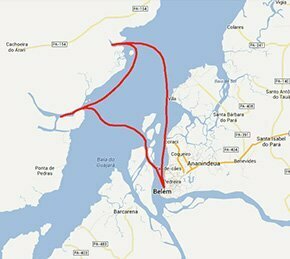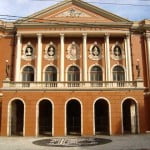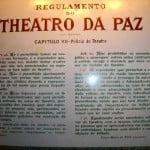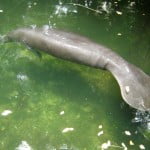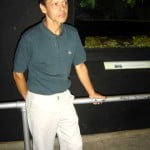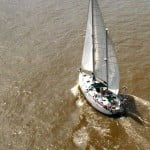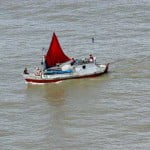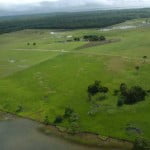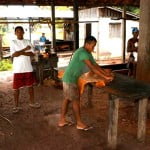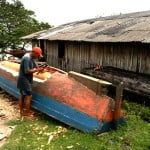21 – 03 – 05 Monday
It was about midday. Our plane had hardly landed, we started to work. We left our luggage in the boat and set out to shoot. During this stage of our journey, we intended to stay two days in Belém to shoot, since there are several old buildings in the city that are very interesting as well as some research institutions that have to be visited if you want to know a little bit more about the history and reality of the Amazon. First of all, we chose the Peace Theater (Teatro da Paz), founded in 1874, from the golden era of rubber. It was worthwhile. It was renovated two years ago and today it is brand new and magnificent. There are 904 seats including the auditorium, boxes and galleries. The seats are made of wood and cane, the ceiling and the side walls are hand painted and elegant chandeliers provide the illumination. From about 1850 until the first years of the 20th century, the per capita income of the states of Pará and Amazonas were higher than that of southern Brazil due to the extraordinary profit resulting from exporting rubber, and the local society was fond of opera seasons and other art shows brought straight from Europe.
Just to give you an idea, Manaus and Belém were the first Brazilian cities supplied with electric light, trolley buses and running water. From 1850 to 1910, the golden era of rubber, the population of these cities jumped from two hundred thousand inhabitants to one million, two hundred thousand.
Then we went to Imazon, a NGO that aims at studying the occupation of the land, the advance of agricultural borders, deforestation, etc. Researchers showed us the problems resulting from the lack of coherent public policies, the damage caused by roads not always significant such as Transamazônica, or the growing soya cultivation at the borders pushing the cattle breeding towards the forest as well as the process of deforestation resulting from both.
A study carried out by Imazon shows that each tree that is sent to a sawmill makes 27 other trees fall in vain which are forgotten there and rotten before they are taken away. Additionally, these sawmills use rudimentary techniques and there is a waste of one third for each log. The worst thing is the fact that this lumber activity is the third industry that creates jobs in the Amazon.
There are six hundred thousand people working in this activity in that area. Therefore, if deforestation is eliminated, there will be a serious social problem seeing that those people would be unemployed. People from São Paulo should be aware of that because we are all concerned: a report from the Department of Strategic Affairs of the Presidency estimates that 80% of the wood that is extracted is illegal and most of it is sold in São Paulo. Consequently, if you live in São Paulo, when you buy furniture or any other object made of wood, you should require that it is guaranteed, thus contributing to diminish the destruction process. There is another serious problem which concerns the lack of inspection. It is hard to believe but Ibama has no more than 600 inspectors in charge of an area that represents 61% of the whole area of the country! Is it possible? As long as this problem is not solved, deforestation will not stop. This situation is very serious and sad. About 600 inspectors for 5,1 million square kilometers, it seems ridiculous and it is close to black humor. And the answer is always the same: there is no money. Yes, but there is always enough money to give the deputees and the senators salary raises as well as enough money for their duties. Now look how the Government spends its money badly. In 2004, the executive squandered on trips, hotel stays and corporate credit cards the astonishing amount of ONE BILLION, ONE HUNDRED MILLION REAIS! During the same period of time, the Program of Prevention and Struggle against Deforestation and Fire spent 37 million reais. Well, this is only another example of bankruptcy in the Brazilian public system. Despite the despoiling taxes we pay, similar to the one paid in rich countries, in return we have services similar to those in Uganda. In Brazil, the public sector is expensive and inefficient. Where just a few government employees are needed there are many, and where many are needed, there are just a few. Someone has already said that Brazilians don’t deserve the ruling elite they have. Whoever said that is completely right. Now look: the Atlantic Forest, the closest to the sea, where Portuguese arrived, was abandoned for 500 years and was reduced to 5 or 7% of its original area. But the Amazon, after being exploited for 40 years, has already lost 15% of its original area. Figure it out and see how many years are left for the richest humid forest of the Planet. As you can see, there is nothing to celebrate.
We were satisfied with the result of the first day of our journey, we had recorded some good interviews, but devastated by what we had heard in the conversations. After we left, we went to the boat at the naval base of the Brazilian Navy in Belém.
22 – 03 – 05 Tuesday
We went by boat early in the morning to Porto do Pará and to the Ver o Peso market in order to shoot. It was hardly daylight when we left. When we arrived in front of the market with all that noise and the fishing boats coming, I saw a very scary scene. When the crew of a sailing boat, some teenagers, noticed we were shooting, decided to grab our attention and played some sort of nautical Russian roulette. Two of them, while the boat was moving, went to the water by the prow of the boat and were there “playing”, grabbing the broadside with only one hand, while the boat kept on moving. I just couldn’t believe it, I felt shivers down my spine.
They could be easily torn to shreds by the boat propeller since the helmsman couldn’t see them.
Before going to Marajó Island, we wanted to get more information from the scientific community about the place we were visiting. That’s why we made some appointments with the researchers from the Emilio Goeldi Museum, one of the glories not only of northern Brazil but also of the whole country. This Museum is the fourth scientific institution founded in Brazil. It was founded in 1866, it is remarkable for its research on the biological and social diversity of the Amazon as well as for participating in projects of environmental and estate education of the region. Before its foundation, Brazil had only the National Museum, the National Observatory and the National Library, all of them in Rio de Janeiro.
There are 300 employees and 80 researchers working for the Emilio Goeldi Museum. The headquarters are downtown in the middle of a magnificent park with 5 hectares surrounded by centennial trees and having a little of all the animal and vegetal diversity of the Amazon: about 600 animals and two thousand plants. There are peixes-boi (a typical mammalian of that area that lives exclusively in the water)in the lake, flamingoes and herons in the woods, jaguars in cages, native orchids in the trunks of trees that are 50 meters high, aquariums with the most exotic and rarest species of that region, one species of the Eden Garden is the background that surrounds the buildings where employees work.
We were welcomed by Joice Santos from the communication advice sector who explained us some of the activities of the museum without hiding her great satisfaction and pride for being part of that institution. It was very nice to see how happy and proud she was as she told us the history and the various trends existing today.
The Swiss scientist, Emilio Goedi, was invited to come to Brazil by governor Lauro Sodré, in 1894, and one year later the headquarters we were visiting were inaugurated.
Today the museum has several activities varying from research to students’ incentive through prizes such as that awarded to young naturalists from primary and secondary schools.
I asked her how much the local citizen and the local society were involved in the activities of the museum and she was jubilant to say that there were 15 museums in Belém , but if you take a taxi and say to the driver “take me to the museum, he will bring you here.”
Then she talked about today’s most important projects such as the “Genoma Net” of environmental modeling, which combines social and economic data with environmental data, remote detection system and mathematical modeling, under the coordination of director Peter Mann de Toledo, aiming at setting up the technological needs to have the environmental detection system in the Amazon. Joice told us that through this system it was possible to see for the first time the connection between the illegal activities and the deforestation line, especially in Marabá and São Feliz do Xingu.
Antonio Messias, another person who works there to whom we talked, was also full of satisfaction and pride as he explained to us and said “it was a privilege to work here”. He is involved in creating hatcheries that show interaction between man and nature and problems resulting from that. He told us: “imagine how nice it would be if we put next to the peixe-boi tank (this mammalian fish eats some types of grass and bamboos) those caboclos’ plantations by the river. They don’t realize that but their plantations advance and destroy the grass. The peixe-boi goes away since there is nothing left to eat. “Creating these hatcheries, our park intends to show the whole chain including the human element in the context.”
Messias loves giving examples. He points out an enormous Sumaumeira in the middle of the park, one of the biggest trees of the forest and says: “João, you should come here in the flowering season of that tree, when parakeets eat the flowers and fruits. After that they spit the seeds on the floor which are immediately eaten by cutias (a rodent mammal) that run freely in the garden.”
We went on with our interviews and talked to researcher Amilcar Mendes who studies the occupation of the coast. He is involved in the Piatam project which is supported by the Federal Universities of Pará and Maranhão as well as by the Research Institute of Amapá.
Amilcar talks about the pollution problems concerning the bay of Guajará in front of the city of Belém. Like in many other cities of our country, sewage is not treated and goes straight into the river. Additionally, he talks about huge problems caused by oil spillages, not due to extraction, which is not the case here, but to transportation. There are several ports near Belém and barges cross the waters of the river from one side to the other carrying oil. If there is an accident during the flood season, the water reservoirs of the city can be easily contaminated. There is also the problem of contamination by the ballast water of the boats and there are many using all the ports here. As you can see, balance here is very precarious…
Before the end of our day, we talked to another researcher from Emilio Goeldi, Denise Schann, geologist, an expert of the Marajó island’s culture.
She told us that the apogee of this culture was between 500 AD and 1300 AD. It was the first complex society of the Brazilian Amazon. At first, established in Marajó and then it spread throughout the lowland of the Amazon. The core of the economy that made it possible was fish exploitation. The eastern side of the island is drier and fishes in the piracema season (the season during which shoals go up the rivers and) go into the lagoons that had been dug, giving origin to the embankments where those people lived. They handled the shoals that were stuck during the dry season. The abundance of food enabled the growing number of inhabitants having cities with 5 to 10 thousand people. The main inheritance was the famous marajoara pottery made of clay and very abundant in that area. Through the drawings, the researcher can decipher them and quite often they tell mythological histories. According to her, the ruin of that people was probably caused by climatic changes.
After all the lessons at Emilio Goeldi we were ready to go to Marajó. But before that, I decided to rent a plane to fly over the mouth of the Pará river, showing Marajó right in the middle of the Amazon Delta, an island made of sediments of the huge river and also take a picture of the Endless Sea with all the sails upright.
Film maker Rodrigo Cartegiano and I went by plane while the rest of the crew, Alonso, Paulina and our guest during this part of the journey, sailman Fernando Cerdeira , went by boat.
23 – 03 – 05 Wednesday
The sailboat left at 5 a.m. We had fixed a point on the map for the appointment at 10.00 a.m. Thus, we left Belém at 8.30 a.m. for Soure, one of the main cities of Marajó. At the airport of the island, we removed the door of the plane in order to shoot freely and we took off again. Later on we were flying above the Endless Sea. We shoot and took pictures of everything. It was also wonderful to see the lagoons of Marajó, the ones Denise had talked about. From the plane we can see in details how they are formed along the rivers. This TV program will be qualitatively better due to the images from the plane.
We didn’t waste any time, as soon as we landed, Rodrigo and I visited the local tannery, that makes shoes and handbags from the skin of buffalos. As you know, Marajó has the greatest herd of buffalos in Brazil. It was very interesting. We also found a shipyard operating behind the tannery, on the river bank. The master carpenter was working on a rotten boat. With an adz in his hand, he was peeling the bottom of the boat to put new boards.
Beside, in the small wooden shed full of primitive tools, there was all the production line: not only the carpenter, but also the calker and the painter. We had a good interview with him.
When we were leaving, I looked at the mouth of the river and I could see farther down Endless Sea enter by the bay of Paracauari. Taking into account that the distance from Belém to Soure is 45 nautical miles, at the east end of Marajó Island, it hadn’t taken too long.
Some minutes later we were all together on board again. Then I was told they had come fast because they had been helped by the flow of the Pará river during the ebb tide reaching a speed limit of 9 nautical miles per hour.
Our boat was anchored near the pier of Soure. The village of Salvaterra was on the other side of the river.
Soure is interesting with art-deco buildings but in a rather bad state. Like Belém the urban area is covered by centennial mango trees. You can see everywhere the huge crowns of these trees. Thank God! The heat is unbearable. Even now in “winter” when in northern Brazil it rains every day. There are 20.000 inhabitants, but the city facilities are in very bad condition. For every meter of paved road, there are dozens of holes. Taxis zigzag at 8, 10 kilometer per hour, if they speed up, they can dismantle. There is a general discontentment against the public power. I asked drivers and ordinary people and I was told that the two last mayors had been impeached for corruption. The present mayor, who had already been elected in the past, had been sued for corruption. According to these people, the process in court had evolved slowly and ended by being null. Thus, one more time the same person ended in the Executive. I asked: How could he be elected, if he had been sued for corruption? Then one of those national ailments emerged, it’s not the only one, neither the most important one, but one among many: a significant part of the press is in politicians’ hands. As far as the radio is concerned, I found out by myself, during the campaign for the end of the compulsory Voz do Brasil! At that time, I had to check who were the owners of the three thousand radio stations operating in Brazil. I found out that 40% of them were in politicians hands. As far as TV channels are concerned, the percentage is nearly the same or higher. Therefore, Marajó is not an exception. “Here in Soure there are 3 radio stations. The AM belongs to the president of the city council, Mr. Mário Couto, from the group of the elected mayor. The owner ofSol FM is Jader Barbalho (who was arrested and put in jail, wandering around in those filthy places, the police stations, do you remember?) from PMDB , the mayor’s political party, that is the same political group. The only radio station left is Tropical FM. And the first two participated in the campaign. But there is more. “I was told that the present mayor, Carlos Augusto Nunes Gouveia, known as Tonga, is being contested for the results of last elections because the ballot boxes had been kept in his brother’s house before the election.” My sources suggest that the results might have been manipulated. It’s difficult to believe, but I’m telling you the story the way it was told to me. Oh! Now I see…
It’s unbelievable! After that mess during the Collor administration, there are still episodes that remind us of that mud and disastrous period that makes every honest Brazilian feel ashamed.
The other problem we had to face was the lack of good hotels. In Soure, there were only two, quite bad and very small. The best one there is on the other side of the river, in Salvaterra. When a tourist is there, he has nothing to do. There is nothing planned or scheduled. No boat renting, no ecological trails, no walks, no sports fishing, nothing. You just lay on the sand and do nothing.
What a pity! Such a disregard from the business community as well as from the public administration. Just to give you an idea, ecological tourism made 260 billion dollars in 2004. Meanwhile in the Amazon where everything has to do with ecological tourism, a huge area that covers nine Brazilian states and 61% of our territory, there are only 17 hotels oriented to ecological tourism, according to Embratur data from the nineties. Present data from 2003 don’t even mention this region. Anyway, here they are: 4 million tourists came to Brazil in 2003 and the main entrance gates were: São Paulo (48,7%), Rio de Janeiro (15,4%), Rio Grande do Sul (15,8%), Paraná (10,5%) and Santa Catarina (1,8%). After these states, in the study it is mentioned “others” (9,8%). Is it possible?
According to Embratur, I found out that 14.330 tourists came to Pará by plane in 2003 and 2.198 by boat. That’s all. Nothing else.
It’s a pity to see all this potential being wasted.
24 – 03 – 05 Thursday
Once again we got up early to talk to people who make the difference. Here in Soure, we met at least two of them who had been recommended by the researchers we talked to in Belém. One is Vazinho, an intelligent and curious person, head of a marine extraction reserve that is doing well. There are about 1.300 families that depend on this reserve. Besides non professional fishing and crab catching (they respect in both cases the closed season) there is the extraction of plants for medicinal purposes and the processing of açai (a Brazilian fruit). However, Vazinho always has problems with local farmers. Although it is officially recognized by Ibama, the area is not yet demarcated. So it is an endless struggle, each part requires the ownership of the area. The situation is so serious that an electric fence was put in some parts of the mangrove to avoid the entrance of people who extract in that area. The other problem he faces and describes in detail is the drag fishing made by boats coming from Belém. Vazinho knows exactly the damage that results from this type of fishing. He mentions the great amount of small fishes that are caught and thrown back dead into the river. Additionally, the professional fishing does not always respect the closed season. According to him, “the problem is that the professional fishing pays taxes to the government and the non professional doesn’t.” Therefore, the authorities disregard this issue.
We had a long conversation with him and fixed another appointment for the day after tomorrow to visit the reserve. Tomorrow is the Good Friday.
After that we met Zeneida Lima. An extraordinary person who calls herself “pajé-cabocla” (pajé is a religious guide and medicine expert among the Indians – cabocla is a woman who is half Indian and half white). Dona Zeneida at the age of 70 has the energy of a teenager. Her parents were farmers from Marajó and she tells a fabulous “story” about something that happened to her when she was a girl, she was mad for no reason, ran to the woods and stayed there for some days. When her family found her, she had already been (I don’t remember exactly the word she used) “elected” or “chosen’ by the Caruanas Indians and she learned with them the art of “Enchantment”. Pajelança , she explains, is a cult to enchantment we inherit from the Indians, and in her case, from the Caruanas.
Besides offering cures to people who look for her, Dona Zeneida does social work in Soure and deserves acknowledgment. Mystic, an expert in legends of that region, in Indians’ customs, old ditties, a composer, a writer of many books, such as “ The mystical world of Caraunas from Marajó Island”, in its 6th edition.
The thing that is really amazing is the school for poor children she built. Those children who could not be accepted by the public system of the island found a safe refuge in her school. It is amazing to look at the pictures and notice the round architecture with many houses each one is an equipped classroom. Children study there, have breakfast and lunch, learn concepts about environmental preservation and maybe their first profession, since those who have some skills take pottery courses, learn how to make sweets made of typical fruits, etc.
I was really surprised to see such a thing here with all those difficulties due to distance and poverty, someone having such a sense of solidarity and citizenship. Congratulations, Dona Zeneida.
And after that tour around the school, after all the walks under that sun and heat, I felt physically bad. Some symptoms suggested insolation. Fortunately, it was time to go back to the boat. We were all exhausted.
25 – 03 – 05 Good Friday
Last night was a nightmare. I threw up, had diarrhea, fever and sweat. I think it was insolation. I couldn’t sleep all night long. That’s the reason why my fellows went out to shoot and I stayed here in the boat, laying and resting on the cockpit under a beautiful awning. My body was asking for rest and I decided to obey strictly to the signs received. The only news today is the arrival of a sailboat of 37 feet from Turkey. It arrived this afternoon with a couple on board. These people are really far from their home.
26 – 03 – 05 Saturday
I was completely recovered. In the morning, we saw a typical dance and music show of Carimbó. A group from the extraction reserve performed it. It was touching. It was a joyful music, contagious, with a strong beat, followed by its corresponding dance with joyful choreographies and performed by the daughters of those people who live in the reserve. Everything rocked by a group with drums, a flute, sorts of rattles and ukeleles. After their show, we went back to the boat and lifted the anchor and went out by the estuary of the river Paracauari, leaving Soure and Salvaterra behind us.
We wanted to arrive at the village of Cachoeira alongside the Arari river about 20 nautical miles down towards Belém on Marajó Island. We lifted the prow sail and the mizzen sail and went fast, helped by the flow of the river Pará. On our way we crossed several typical sail canoes taking non professional fishermen. It is beautiful to see their skills in such simple boats but always efficient. They were also delighted by the view of the Endless Sea. They waved to us and many times showed huge fishes they had just caught.
At the end of the day we anchored at the mouth of the river. In the evening, before dinner, we had a bath in the warm waters of the river Arari, under a starry sky enjoyed a great silence. . This is one of the best moments of the day, after hard work, tired and wet by an extremely hot day, to have a shower, to look at the stars, it’s a privilege for few.
After that, dinner and bed.
27 – 03 – 05 Sunday
Right after breakfast, Fernando Cerdeira, a crew member of this part of the journey, left on the rubber boat ahead of us with a portable echo sound (a device that measures the depth), checks the depth of the river and shows the right way to the Endless Sea. But we didn’t go too far. Six nautical miles ahead and in spite of the high tide, it wasn’t deep enough for our sailboat with a 1 meter and 90 cm keel.
We anchored right there, accompanied by a beautiful forest as we heard different kinds of birds sing from afar.
I decided to go up the river on the rubber boat with filmmaker Rodrigo Cortegiano to ask the caboclos who live alongside the river how far it is to Cachoeira. We were running out of gas and we didn’t have enough money (cash) to buy some gas but if we were lucky and the city were not far, maybe we could arrive there. Unfortunately, that was not the case. According to them, it would take us half an hour by boat and we didn’t have enough gas… anyway I decided to continue a little bit expecting to find good places to shoot. Not away from there we saw a little arm of a river and we entered it. Beautiful! On the river bank there was an amazing forest, untouched, with huge trees, one above the other. All types of plants, different tones of green from the lightest to the darkest one, and many couples of a typical bird, Pavãozinho do Pará (a little peacock). We took pictures and shot dozens of them. It was irresistible, I went a little bit further until the boat was almost stuck by the narrow banks. So I stopped the motor and we stayed there for about 15 minutes and enjoyed the sounds of the forest. We didn’t say a word. We were there just looking at the crowns of the trees while we were hearing the birds sing, in ecstasy with so much beauty.
Finally it started to rain (the traditional rain of this time of the year). Then we decided to go back.
When we were back there was another surprise: a group of pink botos (river dolphins) were fishing beside the sailboat and they stayed there until we left, some hours later. We were also visited by a peixe-boi so rare today. Wonderful!
We had to go back to Belém, cross the river Pará straight on. We had fulfilled our mission of this part of the journey.
On our way back there was a sad thing. We received a message asking for help by Belém radio station and informing the boats near the bay of Marajó about the foundering of the “Oliveira Lima” boat. I answered immediately and asked for more information but they didn’t know in what part of the huge bay the shipwreck was. That boat wasn’t on our horizon, thus, after having heard several boats ask for more information, since the bay is huge, we continued our way.
At six p.m., we anchored again at the pier of “Patromotoria”, at the Naval Base of Belém. Thanks to the Navy of Brazil that has supported the Endless Sea expedition our boat is anchored at the ports under their responsibility. Thus the periods during which the journey doesn’t start again our boat is in places absolutely safe from “water rats”.
The next part of our journey will be hard. We will go from Belém to São Luis, in Maranhão. See you soon.!


